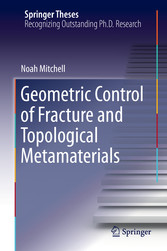Suchen und Finden
Service

Geometric Control of Fracture and Topological Metamaterials
Noah Mitchell
Verlag Springer-Verlag, 2020
ISBN 9783030363611 , 129 Seiten
Format PDF, OL
Kopierschutz Wasserzeichen
Geräte
Foreword
7
Preface
10
Acknowledgments
11
Parts of This Thesis Have Been Published in the Following Journal Articles
12
Contents
13
1 Introduction
16
1.1 Curvature and Geometry
18
1.2 From Geometry to Topology
19
1.3 From Mathematics to Mechanics
21
1.3.1 Curvature and Elasticity in Thin Sheets
22
1.3.2 Berry Curvature, Chern Numbers, and Topological Mechanics
23
1.4 Scope of This Book
28
Part I Gaussian Curvature as a Guide for Material Failure
30
2 Fracture in Sheets Draped on Curved Surfaces
31
2.1 Gaussian Curvature as a Tool
31
2.2 Fracture Onset: Griffith Lengths and Crack Kinking
32
2.2.1 Griffith Length for a Small Crack
34
2.2.2 Crack Kinking
35
2.3 Crack Trajectories
37
2.3.1 Perturbation Theory Prediction of Crack Paths
37
2.3.2 Phase-Field Model on Curved Surfaces
39
2.4 Crack Arrest
42
2.5 Controlling Cracks with More Complex Surfaces
42
2.6 Conclusion
44
3 Conforming Nanoparticle Sheets to Surfaces with Gaussian Curvature
45
3.1 Gaussian Curvature and Nanoparticle Sheets
46
3.2 Experimental Procedure
48
3.3 Monolayer Morphology: Coverage, Cracks, and Folds
49
3.4 Energy Scaling
50
3.4.1 Energy Costs to Conform: Bending and Stretching
52
3.4.2 Alternatives to Elastic Conformation: Avoiding Adhesion, Plastic Deformation, and Folding
52
3.4.3 Three Regimes Arise from Energy Scaling
53
3.5 Bending and Adhesion
54
3.6 Strain Analysis
55
3.6.1 Image Analysis
55
3.6.2 Spring Network Simulations
58
3.6.3 Comparison with Incompressible Solution
60
3.6.4 Azimuthal Cracks in Simulations
60
3.7 Plastic Deformation
61
3.7.1 Formation of Dislocations
61
3.7.2 Formation of Azimuthal Cracks
63
3.8 Formation of Folds at Large Sphere Sizes
64
3.9 Conclusion
64
Part II Topological Mechanics in Gyroscopic Metamaterials
66
4 Realization of a Topological Phase Transition in a GyroscopicLattice
67
4.1 Topological Phase Transitions
67
4.2 Experimental Setup
68
4.3 Broken Symmetries in the Honeycomb Lattice
70
4.4 Breaking Inversion Symmetry in Experiment
70
4.5 Measuring the Topological Phase Transition
72
4.6 Competing Broken Symmetries
74
4.7 Conclusion
76
5 Tunable Band Topology in Gyroscopic Lattices
77
5.1 Gyroscopic Lattices
77
5.2 The Equations of Motion
78
5.3 Twisted Spindle Lattice
80
5.4 Time Reversal Symmetry and Topological Bandgaps
84
5.5 Competing Symmetries in Topological Gyroscopic Systems
85
5.6 Towards Topological Design
87
5.7 Conclusion
89
6 Topological Insulators Constructed from Random Point Sets
90
6.1 Gyroscopic Metamaterials as a Model System
90
6.2 Amorphous Voronoi Networks
91
6.3 Interpretation of the Real-Space Chern Number
93
6.4 Local Geometry Controls Band Topology
95
6.5 Spectral Flow Through Adiabatic Pumping
96
6.6 Broken Time Reversal Symmetry
100
6.7 Conclusion
103
7 Conclusions and Outlook
104
A Creation of Surfaces of Revolution with Prescribed Gaussian Curvature
107
A.1 Governing Equations
107
A.2 Equations for the Surface of a Pseudosphere
108
A.3 Obtaining Geodesic Circles
109
B Stretching Energy in Stamped Sheets on Spherical Surfaces
112
C Symplectic Structure of Gyroscopic Motion
114
D Interpretation of Real-Space Chern Number
117
References
123
Shop


